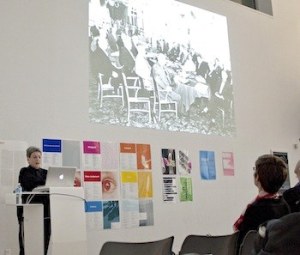Apr 17 2014
Phyllis Lambert‘s devotion to fellow architect Mies van der Rohe has lasted a lifetime and continues to play a role in her career. In an April 14 visit to the Rice School of Architecture (RSA), Lambert delivered a talk about van der Rohe’s work centered on New York’s classic Seagram Building, designed by him and built under her direction.
 Phyllis Lambert delivered the year's final Rice School of Architecture with her talk on "Mies Constructs." Photo by Tami Lynn Andrew/RSA
Phyllis Lambert delivered the year's final Rice School of Architecture with her talk on "Mies Constructs." Photo by Tami Lynn Andrew/RSA
Lambert, who recently published a new book, “Building Seagram,” said plans for the mid-’50s building came “at a time of change in materiality and structure.” She recalled cajoling her father: “If you’re going to build, you have to do something absolutely wonderful.”
At the RSA’s Farish Gallery, where she delivered the Llewelyn-Davies Sahni Innovative Practices Lecture, the final event in the spring lecture series titled “Construct,” Lambert drew upon history and the architect’s own past work to show how the then-radical ideas that defined the Seagram Building came to be, from the glass-walled interiors (“People were terrified,” she said) to the open outdoor terrace that invited public art.
RSA Dean Sarah Whiting, the William Ward Watkin Professor of Architecture, introduced Lambert with a reading of the five key words in what she called one of the most famous letters of modern architecture: “No, no, no, no, no!” The letter, from Lambert to her father, Samuel Bronfman, CEO of the Seagram’s distillery, spelled out in no uncertain terms the young woman’s objections to her father’s plans for the company’s New York City headquarters. Lambert, she said, felt the commissioning of an architect for the building was “a matter of cultural and civic responsibility.”
“In an age in which architects and architectural writers pussyfoot around, anxious not to offend and ultimately end up not saying much of anything, it’s utterly refreshing to read this letter,” Whiting said. “Sixty years later, I can assure you that Phyllis Lambert still knows what she thinks, still knows how to let you know what she thinks.”
The passionate letter was the start of Lambert’s distinguished career as an architect and as a woman of letters who went on to found both the preservation group Heritage Montreal and the Canadian Centre for Architecture, a museum and research center in Montreal. Her father rewarded her boldness by naming her director of planning for the Seagram Building, and she subsequently hired van der Rohe.
Lambert displayed a photo from an early planning session for the building that showed the young woman seated at a conference table with several dozen older men, including van der Rohe and her father. The image is both a sign of the male-dominated field at the time and an apt illustration of her forthright manner.
She recalled a comment the architect made while working on the Seagram Building. “In an interview in 1955, Mies said, ‘I’m not working on architecture, I’m working on architecture as a language. But I think you have to have the grammar in order to have a language. You can use it for normal purposes, and you can speak it in prose. And if you were good at that, you speak in wonderful prose. And if you’re really good, you can be a poet.’”